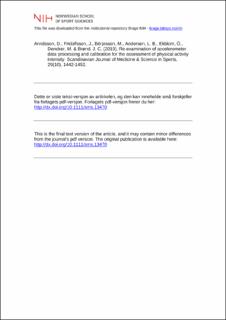| dc.contributor.author | Arvidsson, Daniel | |
| dc.contributor.author | Fridolfsson, Jonatan | |
| dc.contributor.author | Börjesson, Mats | |
| dc.contributor.author | Andersen, Lars Bo | |
| dc.contributor.author | Ekblom, Örjan | |
| dc.contributor.author | Dencker, Magnus | |
| dc.contributor.author | Brønd, Jan Christian | |
| dc.date.accessioned | 2020-05-06T06:39:10Z | |
| dc.date.available | 2020-05-06T06:39:10Z | |
| dc.date.created | 2019-07-09T22:14:32Z | |
| dc.date.issued | 2019 | |
| dc.identifier.citation | Scandinavian Journal of Medicine & Science in Sports. 2019, 29(10), 1442-1452. | en_US |
| dc.identifier.issn | 0905-7188 | |
| dc.identifier.uri | https://hdl.handle.net/11250/2653405 | |
| dc.description | I Brage finner du siste tekst-versjon av artikkelen, og den kan inneholde ubetydelige forskjeller fra forlagets pdf-versjon. Forlagets pdf-versjon finner du på onlinelibrary.wiley.com / In Brage you'll find the final text version of the article, and it may contain insignificant differences from the journal's pdf version. The definitive version is available at onlinelibrary.wiley.com. | en_US |
| dc.description.abstract | This review re‐examines the use of accelerometer and oxygen uptake data for the assessment of activity intensity. Accelerometers capture mechanical work, while oxygen uptake captures the energy cost of this work. Frequency filtering needs to be considered when processing acceleration data. A too restrictive filter attenuates the acceleration signal for walking and, to a higher degree, for running. This measure-ment error affects shorter (children) more than taller (adults) individuals due to their higher movement frequency. Less restrictive filtering includes more movement‐re-lated signals and provides measures that better capture mechanical work, but may include more noise. An optimal filter cut‐point is determined where most relevant acceleration signals are included. Further, accelerometer placement affects what part of mechanical work being captured. While the waist placement captures total me-chanical work and therefore contributes to measures of activity intensity equivalent by age and stature, the thigh and wrist placements capture more internal work and do not provide equivalent measures. Value calibration of accelerometer measures is usually performed using measured oxygen uptake with the metabolic equivalent of task (MET) as reference measure of activity intensity. However, the use of MET is not stringent and is not a measure of activity intensity equivalent by age and stat-ure. A candidate measure is the mass‐specific net oxygen uptake, VO2net (VO2tot − VO2stand). To improve measurement of physical activity intensity using accel-erometers, research developments are suggested concerning the processing of ac-celerometer data, use of energy expenditure as reference for activity intensity, and calibration procedure with absolute versus relative intensity. | en_US |
| dc.language.iso | eng | en_US |
| dc.subject | acceleration | en_US |
| dc.subject | counts | en_US |
| dc.subject | energy expenditure | en_US |
| dc.subject | frequency filtering | en_US |
| dc.subject | mechanical work | en_US |
| dc.title | Re-examination of accelerometer data processing and calibration for the assessment of physical activity intensity | en_US |
| dc.type | Peer reviewed | en_US |
| dc.type | Journal article | en_US |
| dc.description.version | acceptedVersion | en_US |
| dc.source.pagenumber | 1442-1452 | en_US |
| dc.source.volume | 29 | en_US |
| dc.source.journal | Scandinavian Journal of Medicine & Science in Sports | en_US |
| dc.identifier.doi | 10.1111/sms.13470 | |
| dc.identifier.cristin | 1710931 | |
| dc.description.localcode | Seksjon for idrettsmedisin / Department of Sports Medicine | en_US |
| cristin.ispublished | true | |
| cristin.fulltext | postprint | |
| cristin.qualitycode | 2 | |
